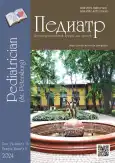Макроамилаземия — редкий вариант гиперамилаземии у детей
- Авторы: Дроздова С.Н.1, Корниенко Е.А.1, Моисейкова Е.Л.1
-
Учреждения:
- Санкт-Петербургский государственный педиатрический медицинский университет
- Выпуск: Том 15, № 4 (2024)
- Страницы: 85-91
- Раздел: Клинический случай
- URL: https://journal-vniispk.ru/pediatr/article/view/279242
- DOI: https://doi.org/10.17816/PED15485-91
- ID: 279242
Цитировать
Аннотация
Макроамилаземия — редкое заболевание, характеризующееся образованием комплекса амилаза-глобулин, который слишком велик для того, чтобы легко выводиться почками, и приводит к повышению уровня амилазы в сыворотке. Это доброкачественное состояние без серьезных признаков и симптомов, которое не требует лечения. Представлен случай длительной бессимптомной гиперамилаземии у ребенка 10 лет. Поступил в отделение гастроэнтерологии с жалобами на боли в животе. С 8 лет необъяснимые повышения уровня амилазы в сыворотке крови до 235 Ед/л и панкреатической амилазы до 63,5 Ед/л, без клинических проявлений панкреатита, при нормальном уровне амилазы мочи, копрологической эластазы. Проведено обследование, в ходе которого исключена патология поджелудочной железы. Соотношение клиренсов амилазы и креатинина составило 0,754 %. Данное соотношение оказалось менее 1 %, что с большей долей вероятности может указывать на макроамизалемию. После дообследования диагностирована макроамилаземия 1-го типа, которая была причиной гиперамилаземии, — не опасная для жизни биохимическая аномалия, предполагающая детальное обследование, широкую дифференциальную диагностику, но не требующая лечения. Тем не менее макроамилаземия представляет собой сложную диагностическую задачу из-за необходимости дифференцировать ее от других причин гиперамилаземии, чтобы избежать ненужных исследований и лечения. Гиперамилаземия является одним из основных диагностических критериев панкреатита, требующего объемного дополнительного обследования и лечения, нередко в условиях стационара. Важно, чтобы врачи на начальном этапе могли распознавать и диагностировать макроамилаземию во избежание ненужных диагностических и лечебных мероприятий. В связи с этим мы надеемся, что приведенный клинический пример будет интересен и полезен для врачей различных специальностей.
Ключевые слова
Полный текст
Открыть статью на сайте журналаОб авторах
Светлана Николаевна Дроздова
Санкт-Петербургский государственный педиатрический медицинский университет
Автор, ответственный за переписку.
Email: s.drozdova@mail.ru
ORCID iD: 0009-0009-2163-4778
SPIN-код: 9129-4393
канд. мед. наук, доцент кафедры детских болезней им. профессора И.М. Воронцова факультета послевузовского и дополнительного профессионального образования
Россия, 192100, Санкт-Петербург, ул. Литовская, д. 2Елена Александровна Корниенко
Санкт-Петербургский государственный педиатрический медицинский университет
Email: elenkornienk@yandex.ru
ORCID iD: 0000-0003-2743-1460
SPIN-код: 5120-9007
д-р мед. наук, профессор кафедры детских болезней им. проф. И.М. Воронцова факультета послевузовского и дополнительного профессионального образования
Россия, 192100, Санкт-Петербург, ул. Литовская, д. 2Екатерина Леонидовна Моисейкова
Санкт-Петербургский государственный педиатрический медицинский университет
Email: igumenjva@mail.ru
ORCID iD: 0009-0000-5043-8965
SPIN-код: 6581-9294
канд. мед. наук, доцент кафедры детских болезней им. проф. И.М. Воронцова факультета послевузовского и дополнительного профессионального образования
Россия, 192100, Санкт-Петербург, ул. Литовская, д. 2Список литературы
- Воронцов И.М., Мазурин А.В. Пропедевтика детских болезней. 3-е изд. Санкт-Петербург: Фолиант, 2009.
- Губергриц Н.Б., Беляева Н.В., Лукашевич Г.М., Можина Т.Л. Тайны, загадки и мистерии макроамилаземии // Вестник клуба панкреатологов. 2020. Т. 46, № 1. С. 12–22. EDN: IVMAIZ
- Минина С.Н., Корниенко Е.А., Суспицын Е.Н., Имянитов Е.Н. Этиологическая структура, диагностические критерии и принципы лечения панкреатитов у детей // Вопросы детской диетологии. 2020. Т. 18, № 3. С. 54–64. EDN: JAVOQV doi: 10.20953/1727-5784-2020-3-54-64
- Никольская К.А., Бордин Д.С., Винокурова Л.В., и др. Гиперамилаземия — всегда ли это панкреатит? // Фарматека. 2019. № 2. С. 130–135. EDN: VVYXEQ doi: 10.18565/pharmateca.2019.2.130-35
- Ягупова А.А., Корниенко Е.А., Лобода Т.Б., Фадина С.А. Новый диагноз в детской практике: аутоиммунный панкреатит // Педиатр. 2013. Т. 4, № 4. С. 48–55. EDN: QFLZEA doi: 10.17816/PED4448-55
- Depsames R., Fireman Z., Niv E., Kopelman Y. Macroamylasemia as the first manifestation of celiac disease // Case Rep Gastroenterol. 2008. Vol. 2, N 2. P. 196–198. doi: 10.1159/000132771
- Fujimura Y., Nishishita C., Uchida J., Iida M. Macroamylasemia associated with ulcerative colitis // J Mol Med (Berl). 1995. Vol. 73. P. 95–97. doi: 10.1007/BF00270584
- Gallucci F., Buono R., Ferrara L., et al. Chronic asymptomatic hyperamylasemia unrelated to pancreatic diseases // Adv Med Sci. 2010. Vol. 55, N 2. P. 143–145. doi: 10.2478/v10039-010-0049-9
- Joksimovic Z., Bastac D., Pavlovic S. Macroamylasemia as a cause of hyperamylasemia in clinically unclear conditions: case report // Timoc Med Glas. 2020. Vol. 45, N 1–2. P. 68–72. doi: 10.5937/tmg2001068J
- Lam R., Muniraj T. Hyperamylasemia. Treasure Island (FL): StatPearls Publishing, 2021.
- Šimac D.V., Špelić M. Using polyethylene glycol precipitation to confirm macroamylasemia // Acta Med Croatica. 2020. Vol. 74, N 3. P. 293–294.
- Simac D.V., Spelic M., Devcic B., Racki S. Diagnosing macroamylasemia in unexplained hyperamylasemia // Acta Med Croatica. 2017. Vol. 71, N 1. P. 63–66.
- Tseng Y., Luo Z., Zhang H., et al. Asymptomatic hyperamylasemia in Stevens–Johnson syndrome is associated with intestinal barrier dysfunction // Biomed Res Int. 2020. Vol. 2020. ID 3531907. doi: 10.1155/2020/3531907
Дополнительные файлы






